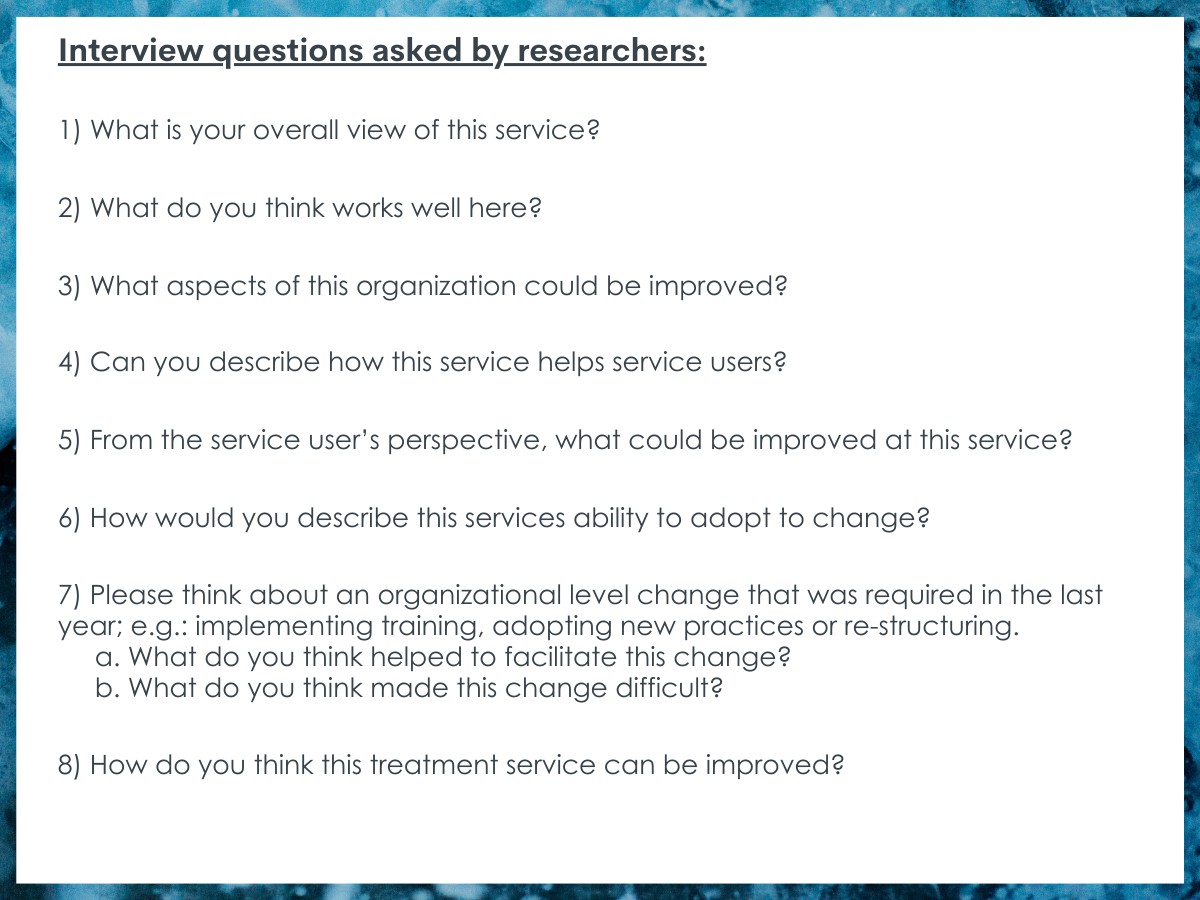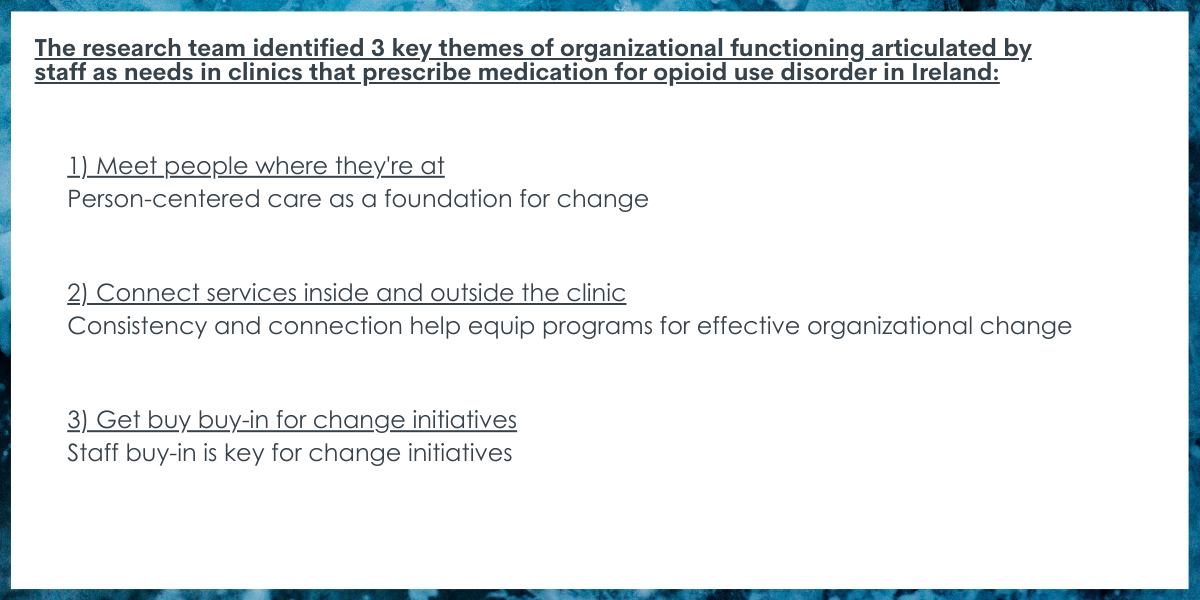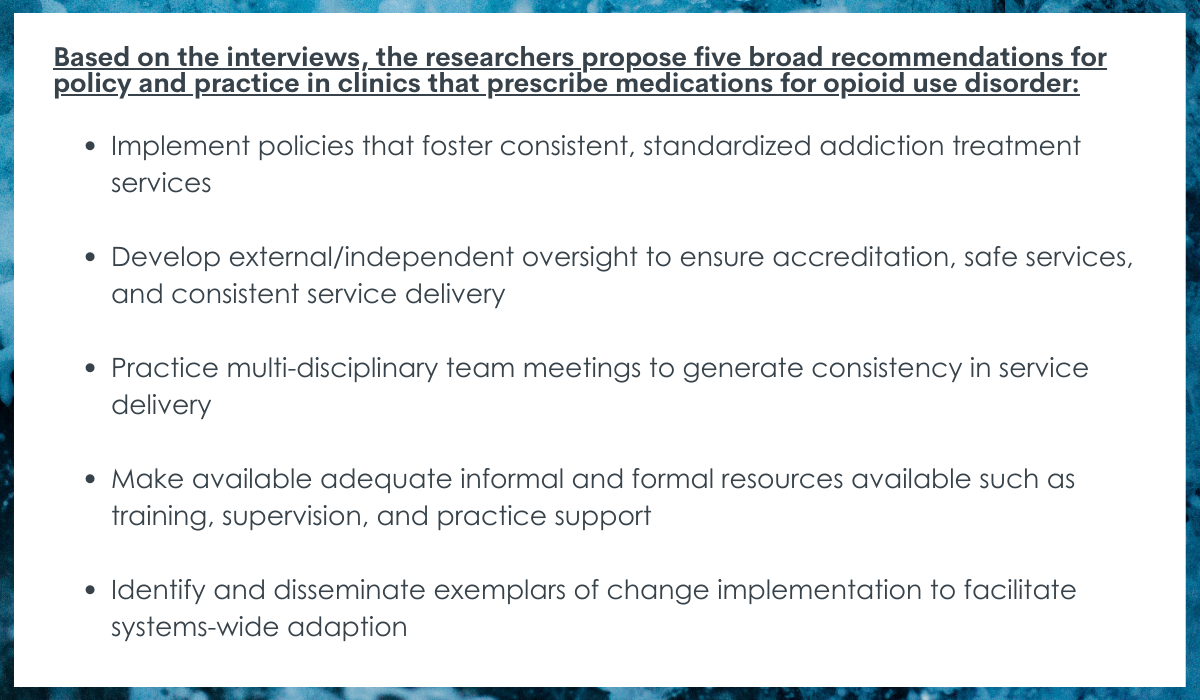Organizational change in community-based addiction clinics
Addiction services with programs that offer medication for opioid use disorder are informed by several stakeholders including researchers, policy makers, providers, and the patients themselves. Thus, with so many inputs, adapting services to meet changing needs can be complex. This study explored organizational functioning and the potential for change among staff at clinics in Ireland.
WHAT PROBLEM DOES THIS STUDY ADDRESS?
Medications, such as buprenorphine and methadone, are helpful treatments for individuals with opioid use disorder and have been found to reduce overdose mortality and use of opioids. However, only a sub-set of individuals with opioid use disorder receive treatment and, of those, less than half receive opioid use disorder medications both nationally in the U.S. and internationally. Understanding why this is the case is critically important. One clue might have to do with the organizational effectiveness of clinics that prescribe and treat patients with opioid addiction.
Researchers in the field of dissemination and implementation science suggest that a vital component of health services is the context in which services are administered. Understanding how to deliver effective, evidence-based treatment for individuals with opioid use disorder may require a focus on organizational functioning among community-based addiction treatment services. Exploration into the inner workings of prescribing clinics may further reveal important dynamics to consider in the process of improving addiction services.
A health clinic, such as a community-based clinic prescribing medications for opioid use disorder, is a complex eco-system, and services may be influenced by service users, staff, clinic culture, and policy. Programs are best positioned to improve their patients’ outcomes when also prioritizing the well-being of program providers and staff. They are also better positioned when they are equipped to implement the best available research dynamically and effectively.
Previous research has found that an organization’s readiness to change – how willing and able staff are to support organizational change – is linked to service implementation. Perceptions of a treatment program’s organizational readiness to change has been found to be significantly linked with implementing evidence-based addiction treatment. Research that focuses on how staff perceive and experience change within their own clinic may provide insights into organizational functioning for future service delivery improvement, a type of “dissemination and implementation” research. In this study, staff at prescribing clinics in Ireland were interviewed and asked about their organization’s functioning and experiences with change.
HOW WAS THIS STUDY CONDUCTED?
This was a qualitative study based on individual interviews to examine how staff of Irish clinics that provide medication for opioid use disorder experience and perceive organizational functioning at their clinic. In this study, the research team interviewed 12 individual staff members representing 10 different geographic locations in southern Ireland and used these data to develop overarching themes. Interviews were conducted between June 2019 and March 2020.
Participants were recruited from 12 publicly funded Irish clinics that prescribe medication for opioid use disorder, which is estimated to represent approximately 40% of all such clinics in Ireland. Researchers conducted semi-structured interviews that probed organizational functioning and ability to adapt to change. Interviewees were asked questions to garner perceptions about what works well in the organization, how clinic services assist service users, how services change, what has facilitated or hindered change, and what could be improved.

After the interviews were completed, the interviews were transcribed verbatim. Content analysis was then conducted to identify the codes, sub-categories, categories, and themes. The lead researcher first read all interviews and developed an initial list of possible codes. Through an iterative process, several of the researchers jointly reviewed, cross-checked, honed, and reconciled a list of codes. After the interviews were all reviewed, the codes were collapsed into sub-categories, categories, and themes. This inductive approach also entailed the research team meeting regularly to review, develop consensus, and ensure coding consistency across all the interviews. The researchers also practiced reflexive journaling throughout the processes to explore possible connections, biases, and interpretations of data. The researchers enhanced the credibility of their research by triangulating themes through multiple coders, examining inter-rater reliability, receiving qualitative research training, and practicing reflexivity through journaling and discussion.
Seven women and 5 men that were predominately white Irish participated. Participants were on average 49 years old, worked or volunteered at least 14 hours per week in a prescribing clinic, and had been with the individual clinic for an average of 5 years. Nine participants reported a college degree, 3 reported a master’s degree, and 1 reported a PhD. They were all members of multi-disciplinary teams that comprised permanent and part-time prescribers, nurses, counsellors, psychologist, social workers, drug workers, and general assistants. Four participants were from a medical or nursing background, five were from a counselling or psychology background, and 3 worked as drug workers or general assistants. Part-time prescribers were typically non-addiction specialist general practitioners working within their own practice who prescribe medication for opioid use disorder during one or two days set aside for those services.
WHAT DID THIS STUDY FIND?
The research team identified 3 key themes of organizational functioning articulated by staff as needs in clinics that prescribe medication for opioid use disorder in Ireland. The need to:
- Meet people where they’re at
- Connect services inside and outside the clinic
- Get buy buy-in for change initiatives

Person-centered care as a foundation for change.
One of the largest drivers of past changes and future aspirations were the perceived needs of service users. Participants reported the importance of the relationships between service users and staff as well as amongst staff in meeting needs. To this end, participants felt that clinic staff are centering patient needs in many ways as they deliver services. However, participants also shared that the services were not always attuned to the comprehensive needs of service users but instead were overly focused on prescribing and urine toxicology screens.
Additionally, participants shared how the ethos of the clinics has been shifting from abstinence based and ideologically driven towards “compassionate pragmatism”. The current paradigm centers service users and takes an evidence-based approach, which entails a stronger harm reduction leaning to service provision. This change was reported to have increased the range of psycho-social supports and more flexibility in prescribing regimes. Staff noted positive changes yet also shared their dissatisfaction with the “old way” of doing things. The change in organizational ethos was not marked by a single event but by a larger shift in the culture of addiction services. Some participants also attributed these changes to part of a societal trend such that people who use substances are being viewed with more passion along with changes in national policy, both of which influence clinic practices.
Consistency and connection help equip programs for effective organizational change.
Participants in the study repeatedly shared how practices within clinics, between clinics, and with outside services lacked standardization, which hindered each organization’s ability to retain staff, implement organizational changes, and meet service user needs.
Organizational changes were often cited as a result of staff identifying needs of service users that were not being met. However, organizational culture and practices such as rigid staff hierarchies, strict roles, not having clear clinical leadership, inconsistencies in implementing standard operating procedures, and not addressing poor performance of staff were reported to be a barrier to change. These barriers were also noted to reflect the broader culture in health services and government.
Participants also reported that prescribing services were disconnected from other services, such as legal, housing, or other health services. Despite, seeing improvements over the years, participants still saw the need for clinics and the larger system to ‘join the dots’. The lack of standardization and unclear connections internally and externally were also cited as reasons for poor staff retention. Staff turnover was viewed as a large barrier to implementing and sustaining organizational change.
Staff buy-in is key for change initiatives.
Participants shared that the success or maintenance of change was influenced by the implementation of staff training, changes in available resources, multi-level buy-in, or some combination of these. All but one staff member noted they had access to training, and most staff also noted an increasing confidence in their organization’s ability to change.
Clinic managers were also seen as important drivers and supports of change. Participants mentioned that getting buy-in from managers was imperative for successful change implementation. Two other key components of effective change implementation were the actual measurement of change and the follow through of staff. Change required not only the resources to implement change but also the buy-in required to monitor change, such as clinical audits.
Another resource that was viewed as a connecting piece yet also an important resource was staff supervision. Clinical supervision was identified by staff as something that aids the implementation of new ideas and/or training. However, staff reported the desire that all staff, including medical, received supervision because they believed it was an important resource to process and work through day-to-day experiences.
WHAT ARE THE IMPLICATIONS OF THE STUDY FINDINGS?
Opioid use disorder impacts public and private systems around the world. Although strong evidence exists for the efficacy of medications for opioid use disorder, many individuals do not receive care or discontinue it in Ireland. Researchers in the field of dissemination and implementation science propose that a key piece of understanding health services is understanding the context in which the services are provided. The researchers in this study sought to gain understanding of how staff at addiction clinics in Ireland perceive their clinic’s functioning and experience with change.

Program and service user outcomes as well as the perceptions of people who use drugs will be important areas for future study. Although clinic staff perceive that they are adapting to meet service user needs, empirical investigation is needed to confirm this belief. Furthermore, there was high variability in programming. Future research would benefit from exploring which types of programs and program characteristics work best for different types of patients. Although national strategies exist to coordinate services, addiction clinic staff still see a need for a more systemic approach to planning and delivering services. A more systemic approach would necessitate greater cohesion between policy makers, system planners, staff, and service users.
Organizations, such as addiction clinics in Ireland, are their own ecosystem yet also nested in a wider ecosystem that is made up of individuals who use services, organizations in the community, and larger cultural or political arenas. Consistent with the recovery-oriented systems of care paradigm, the researchers in this study found that clinic functioning and adaption to change was impacted by internal (e.g., relationships, operating procedures, team meetings) and external (e.g., other health services, culture, national policy, stigma) forces. A consideration of the entire system of care could enhance not only internal dynamics but also each clinic’s ability to connect with and leverage existing community resources. When considering how to change services to meet the needs of those seeking treatment, researchers and practitioners may benefit from investigating the larger ecosystem of addiction services.
- LIMITATIONS
-
- The sample included a subset of clinics in Ireland that prescribe medication for opioid use disorder, thus findings may not represent all addiction clinics in Ireland or clinics in other parts of the world.
- The researchers did not collect outcome data and, therefore, any inferences about the staff perceptions of effectiveness of these programs should not be inferred without future longitudinal research.
BOTTOM LINE
This qualitative study found that staff of Irish addiction clinics viewed their organization’s ability to adapt to change as relying on three interrelated needs: meeting people where they are at, connecting services internally and with outside providers, and getting buy-in for change initiatives. Community-based clinics that prescribe medications for opioid use disorder are an important component of a recovery-oriented system of care and understanding their internal functioning may help future research and policy support service delivery. Future research should examine if organizational functioning and ability to adopt to change are linked with service user outcomes. If these findings show improved outcomes, then practitioners and policy makers may move to target organizational functioning.
- For individuals and families seeking recovery: The researchers in this study highlight how addiction clinics are complex and dynamic organizations. Clinics are impacted by a range of internal and external forces. Supporting addiction services broadly and the system of care locally may help increase the positive effect of individual addiction services.
- For treatment professionals and treatment systems: This study found that addiction clinics are subject to a variety of pressures and motivations. Key drivers of change were the needs of services users. However, internal and external barriers to care delivery were identified that hinder the ability of clinics to change. Addiction clinics seeking to improve organizational functioning and potentially service outcomes may consider examining their internal dynamics, connections to other organizations, and buy-in for change initiatives. Identifying areas for improvement in organizational functioning is likely to help and unlikely to hurt the delivery of addiction services.
- For scientists: The research team explored perceptions of organizational functioning and ability to change among staff at Irish clinics prescribing medications for opioid use disorder. The qualitative exploration yielded nuanced insights into how clinic functioning and change adoption was impacted by internal and external forces. Future investigation may seek to quantify the effect of organizational functioning on patient outcomes in Ireland. Additional qualitative investigation of clinic functioning as experienced by service users may also complement the present study. Further research may also explore the systems of care that are in place and their influence on clinic functioning both within local communities, across Ireland, and in other nations.
- For policy makers: Findings from this study suggest that clinics providing medication for opioid use disorder are dynamic and complex. Perceptions of staff indicate that implementing policies to standardize care and monitor care provision could improve organizational functioning and the clinic’s ability to meet the needs to service users. Policies providing additional resources (e.g., training, supervision, and infrastructure) along with research exploring their effectiveness will likely improve outcomes for individuals with opioid use disorder.
CITATIONS
Peter, K., Hegarty, J., R., D. K., & O Donovan, A. (2022). ‘They don’t actually join the dots’: An exploration of organizational change in Irish opiate community treatment services. Journal of Substance Abuse Treatment, 135, 108557. doi: 10.1016/j.jsat.2021.108557

